
Catalog excerpts

Opti-Sciences Inc. 8 Winn Avenue Hudson, NH 03051 www.optisci.com 603-883-4400 Integrated Fluorometer iFL N E W Technology Leadership First to offer white actinic light LED that allows chloroplast migration, responsible for up to 30% of NPQ & xanthophyll cycle photo-protection. First to offer leaf absorptance measurement for more reliable J measurements. Absorptance varies from 0.7 to 0.9 in heathy leaves and varies with light intensity! First to offer a “matched measurement” automatically every time, with an auto-zeroed IRGA First to offer humidity control above and below ambient. Humidity and flow rate may be held constant. First to offer “walk away automation” - push a button and come back hours later for results. First to offer automated “post processing” for the Laisk protocol, the Kok protocol, the Yin protocol, and the Flexas chamber leakage protocol. First to offer direct readout of gm, CC, Rd,G*, VCMAX & JMAX Optimal improvement - FM’ correction of Y(II) and J values according to Loriaux 2013 8-16 hour battery charge life for one battery! IR sensor measures leaf temperature over a larger leaf area - for more reliable measurements at non-ambient leaf chamber temperatures (Pons T., Flexas J., von Caemmerer S., Evans J.R., Genty B., Ribas-Carbo M. & Brugnol E. 2009) This instrument is a joint venture between ADC BioScientific and Opti-Sciences Inc. It continues a tradition of innovation. ADC BioScientific developed the first photosynthesis measuring system base on IRGAs in 1970. It was also the first company to develop the revolutionary “open mode” design that is now used by all major suppliers. Opti-Sciences, started in 1993, has prided itself on leading technology, automation of instrument housekeeping functions, and reliable measuring instrumentation. The iFL was designed to improve on existing instruments with an eye on the latest research, the best methods, and the latest technology improvements. The iFL is also very easy to use. It lets users concentrate on research while automating housekeeping functions that are better done with
Open the catalog to page 1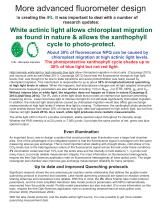
More advanced fluorometer design In creating the iFL, it was important to deal with a number of research updates: White actinic light allows chloroplast migration as found in nature & allows the xanthophyll cycle to photo-protect. Cells - chloroplast migration About 30% of fluorescence NPQ can be caused by chloroplast migration at high actinic light levels. The photoprotective xanthophyll cycle shades up to 30% of blue light but not red light. High intensity white light or high intensity blue light allow chloroplast migration in dicot cells (Cazzaniga 2013) and monocot cells as well (Maai...
Open the catalog to page 2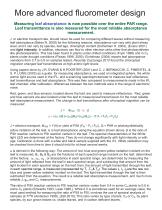
More advanced fluorometer design Measuring leaf absorptance is now possible over the entire PAR range. Leaf transmittance is also measured for the most reliable absorptance measurement. J, or electron transport rate, should never be used for comparing different leaves without measuring leaf absorptance (Baker N. 2008) for the following reasons: absorptance can vary with plant stress level, and it can vary by species, leaf age, chlorophyll content (Eichelman H. 2004), (Evans 2001) and light intensity. In addition, electrons can flow to other electron sinks other that photosynthesis like...
Open the catalog to page 3
Why use an integrated Chlorophyll Fluorometer - Gas Exchange System? Progress in the field of measuring the light and dark reactions of photosynthesis continue. J, or electron transport rate, from the light reaction has been used in conjunction with gas exchange measurements for some time. The combination allows investigation into rate of mesophyll conductance of CO2 , gm, and CO2 at the site of carboxylation or Cc, among other areas. gm allows measurement of another form or level of CO2 resistance as it flows from substomatal cavities to the the sites of carboxilation in chloroplasts. The...
Open the catalog to page 4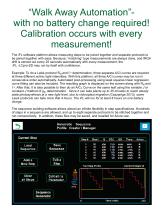
“Walk Away Automation”with no battery change required! Calibration occurs with every measurement! The iFL software platform allows measuring steps to be joined together and separate protocols to be joined together with ease. Because, “matching” type measurements are always done, and IRGA drift is zeroed out every 25 seconds automatically with every measurement, the iFL -LCpro-SD may run by itself with confidence. Example: To do a Laisk protocol Rd and G* determination, three separate A/Ci curves are required at three different actinic light intensities. With this platform, all three A/Ci...
Open the catalog to page 5
Step by step routines included for much easier operation ADC BioScientific and Opti-Sciences believe that instrument operation should be as easy as possible. Instruments need to be flexible enough to investigate new frontiers in science, and easy enough for new users to operate with confidence. Software sophistication, and automation of instrument housekeeping functions allows the iFL to walk instrument operators through the most complicated measurements and routines with ease. Routine tempates exist for several common types of measurements • A/Q - light response curves • Laisk Rd and r*...
Open the catalog to page 6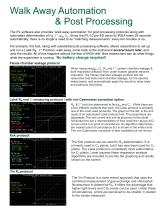
Walk Away Automation & Post Processing The iFL software also provides "walk away automation" for post processing protocols along with automated determination of R^ r*, gm, Cc. Since the iFL-LCpro-SD zeros its IRGA every 25 seconds automatically there is no longer a need to do "matching measurements" every ten minutes or so. For example, this fact, along with substantial post processing software, allows researchers to set up and run a Laisk Rd , r* Protocol, walk away, come back to the instrument several hours later, and view the results. All of this happens without the fear of IRGA drift....
Open the catalog to page 7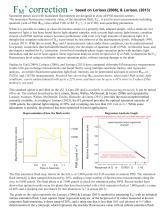
based on Loriaux (2006), & Loriaux, (2013) Saturation pulses used with modulated fluorometers are designed to close all PSII reaction centers. The maximum fluorescence intensity value, of the saturation flash, FM’, is used in most measurements including, quantum yield of PSII MPSII (also called Y(II) or )F /FM’ ), J (or ETR), and quenching parameters. While it is possible to reduce or close all reaction centers in a properly dark adapted sample, with a relatively low amount of light, it has been found that in light adapted samples, with a recent high actinic light history, complete closure...
Open the catalog to page 8




















